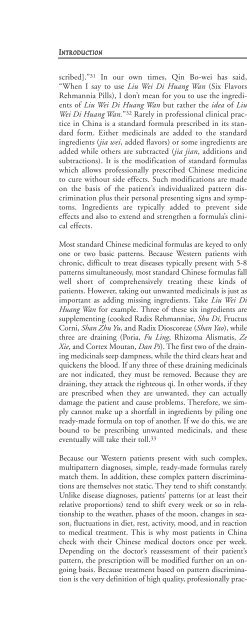The Treatment of Modern Western - Biblio.nhat-nam.ru
The Treatment of Modern Western - Biblio.nhat-nam.ru
The Treatment of Modern Western - Biblio.nhat-nam.ru
- No tags were found...
You also want an ePaper? Increase the reach of your titles
YUMPU automatically turns print PDFs into web optimized ePapers that Google loves.
INTRODUCTION 33scribed].” 31 In our own times, Qin Bo-wei has said,“When I say to use Liu Wei Di Huang Wan (Six FlavorsRehmannia Pills), I don’t mean for you to use the ingredients<strong>of</strong> Liu Wei Di Huang Wan but rather the idea <strong>of</strong> LiuWei Di Huang Wan.” 32 Rarely in pr<strong>of</strong>essional clinical practicein China is a standard formula prescribed in its standardform. Either medicinals are added to the standardingredients (jia wei, added flavors) or some ingredients areadded while others are subtracted (jia jian, additions andsubtractions). It is the modification <strong>of</strong> standard formulaswhich allows pr<strong>of</strong>essionally prescribed Chinese medicineto cure without side effects. Such modifications are madeon the basis <strong>of</strong> the patient’s individualized pattern discriminationplus their personal presenting signs and symptoms.Ingredients are typically added to prevent sideeffects and also to extend and strengthen a formula’s clinicaleffects.Most standard Chinese medicinal formulas are keyed to onlyone or two basic patterns. Because <strong>Western</strong> patients withchronic, difficult to treat diseases typically present with 5-8patterns simultaneously, most standard Chinese formulas fallwell short <strong>of</strong> comprehensively treating these kinds <strong>of</strong>patients. However, taking out unwanted medicinals is just asimportant as adding missing ingredients. Take Liu Wei DiHuang Wan for example. Three <strong>of</strong> these six ingredients aresupplementing (cooked Radix Rehmanniae, Shu Di, F<strong>ru</strong>ctusCorni, Shan Zhu Yu, and Radix Dioscoreae (Shan Yao), whilethree are draining (Poria, Fu Ling, Rhizoma Alismatis, ZeXie, and Cortex Moutan, Dan Pi). <strong>The</strong> first two <strong>of</strong> the drainingmedicinals seep dampness, while the third clears heat andquickens the blood. If any three <strong>of</strong> these draining medicinalsare not indicated, they must be removed. Because they aredraining, they attack the righteous qi. In other words, if theyare prescribed when they are unwanted, they can actuallydamage the patient and cause problems. <strong>The</strong>refore, we simplycannot make up a shortfall in ingredients by piling oneready-made formula on top <strong>of</strong> another. If we do this, we arebound to be prescribing unwanted medicinals, and theseeventually will take their toll. 33Because our <strong>Western</strong> patients present with such complex,multipattern diagnoses, simple, ready-made formulas rarelymatch them. In addition, these complex pattern discriminationsare themselves not static. <strong>The</strong>y tend to shift constantly.Unlike disease diagnoses, patients’ patterns (or at least theirrelative proportions) tend to shift every week or so in relationshipto the weather, phases <strong>of</strong> the moon, changes in season,fluctuations in diet, rest, activity, mood, and in reactionto medical treatment. This is why most patients in Chinacheck with their Chinese medical doctors once per week.Depending on the doctor’s reassessment <strong>of</strong> their patient’spattern, the prescription will be modified further on an ongoingbasis. Because treatment based on pattern discriminationis the very definition <strong>of</strong> high quality, pr<strong>of</strong>essionally practicedChinese medicine and patterns are so fluid and everchanging,treatment must allow for easy modification.Ready-made medicines do not allow for this.THE ISSUE OF PROCESSINGIn Chinese, the processing <strong>of</strong> Chinese medicinals prior todecoction is called pao zhi. Within Chinese medicine, thereare a number <strong>of</strong> different methods <strong>of</strong> this processing. Some<strong>of</strong> these methods are only for ease <strong>of</strong> storing or handling.Other methods are nothing more than cleaning, while yetother methods are, when all is said and done, not much morethan cosmetic. However, many <strong>of</strong> these methods actuallychange the properties (i.e., nature and/or flavor), functions,and indications <strong>of</strong> medicinals. According to PhilippeSionneau, we cannot regard uncooked and honey mix-friedRadix Astragali (Huang Qi) as the same medicinal any morethan Huang Qi and Radix Angelicae Sinensis (Dang Gui) arethe same medicinals. Once a medicinal has undergone processing,it becomes a different medicinal with different indications.Although we have tried to keep the use <strong>of</strong> processed medicinalsto a minimum in this text, processing does add a wholeother level <strong>of</strong> sophistication and efficacy to the prescription <strong>of</strong>Chinese medicinals. Some ready-made medicines are madewith properly processed medicinals, but others are not, and,when using a ready-made medicine, we cannot process a particularingredient so that it can have an even stronger, moretargeted effect with less potential side effects. <strong>The</strong> fact that wecannot further refine and tailor a prescription via processing isyet another drawback <strong>of</strong> ready-made medicines. For mostcommon processing methods, all one needs is a wok, a hotplate, some water, and a handful <strong>of</strong> common household foodstuffs,such as salt, bran, rice, honey, vinegar, and alcohol. Inaddition, many Chinese medicinal suppliers, at least in theU.S., sell already processed versions <strong>of</strong> the most commonlyprocessed Chinese medicinals. <strong>The</strong>refore, it is not that difficultto use processed Chinese medicinals in most <strong>Western</strong> clinicalpractices. For more information on processing and the use <strong>of</strong>processed Chinese medicinals, readers should see PhilippeSionneau’s Pao Zhi: An Introduction to the Use <strong>of</strong> ProcessedChinese Medicinals also available from Blue Poppy Press.THE ISSUE OF DOSEWhen we said above that the kinds <strong>of</strong> difficult to treat, knottyconditions which are the stock in trade <strong>of</strong> <strong>Western</strong> practitionerscommonly require “large” prescriptions, we meanttwo things. First, Chinese formulas for these kinds <strong>of</strong> conditionstypically have more than 12 ingredients and <strong>of</strong>ten 15,18, or even more than 20. If our average patient has 5-8 patternssimultaneously and most practitioners use at least twoingredients per disease mechanism, most Chinese medicinalformulas for these kinds <strong>of</strong> conditions will have at least a
















